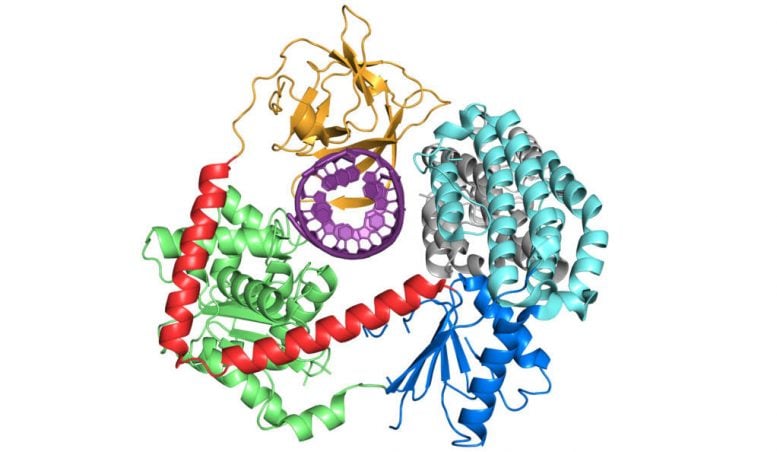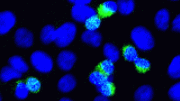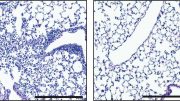
A diagram of the RIG-I protein. RIG-I is a vital immune system sensor found in humans and animals. It detects viral RNA, envelops it, binds to it, and activates the immune system to respond.
Yale researchers have developed a set of synthetic molecules that may help boost the strength of a key, virus-fighting protein.
The protein, RIG-I, is an important sensor in the immune system of humans and other animals. It recognizes and responds to viral RNA by surrounding it, latching onto it, and launching the immune system into action.
The Yale team, led by biologists Anna Pyle and Akiko Iwasaki, has designed molecules that jump-start the process. These synthetic, stem-loop RNA (SLR) molecules can be visualized as short cords with a knot at one end. The configuration enables the SLRs to bind with RIG-I molecules in a way that prompts an aggressive response.
“When you tickle RIG-I with this small, RNA hairpin, it alerts the body that it’s time to respond,” said Pyle, professor of molecular, cellular, and developmental biology, and of chemistry, at Yale, and co-corresponding author of a study published online February 21 in the journal Science Advances.
“This gives us a tool that can help with everything from the design of better vaccines to better antivirals and anti-cancer therapies,” Pyle said.
The new study represents the first time scientists have been able to specifically manipulate and analyze the RIG-I biosensor in a living animal — in this case, mice. The Yale researchers said further study is needed in order to gauge the potential for developing new drugs for everything from flu to various forms of cancer.
“I was shocked to see how potent this small RNA molecule is in stimulating antiviral interferon responses in mice. For its specificity and potency, we now use SLR for all of our RIG-I research in the lab,” said Iwasaki, professor of immunobiology and of molecular, cellular, and developmental biology, and co-corresponding author of the study.
Iwasaki and Pyle are also Howard Hughes Medical Institute investigators and members of the Yale Cancer Center.
Yale has conducted extensive research on RIG-I and related proteins in the past decade. That work included the first detailed description of the major mechanical components of RIG-I and how the components work in concert.
The first author of the new study is Melissa Linehan. Additional authors are Thayne Dickey, Emanuela Molinari, Megan Fitzgerald, and Olga Potapova.
The Howard Hughes Medical Institute and awards from the National Institutes of Health supported the research.
Reference: “A minimal RNA ligand for potent RIG-I activation in living mice” by Melissa M. Linehan, Thayne H. Dickey, Emanuela S. Molinari, Megan E. Fitzgerald, Olga Potapova, Akiko Iwasaki and Anna M. Pyle, 21 February 2018, Science Advances.
DOI: 10.1126/sciadv.1701854









Be the first to comment on "Biologists Design Synthetic Molecules to Help Boost the Immune System"